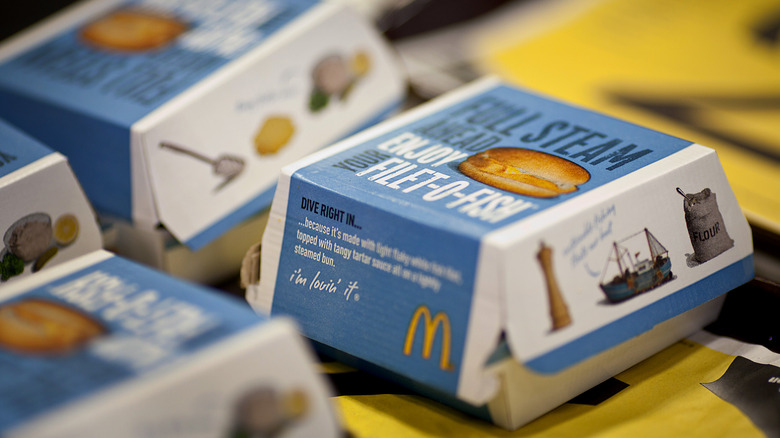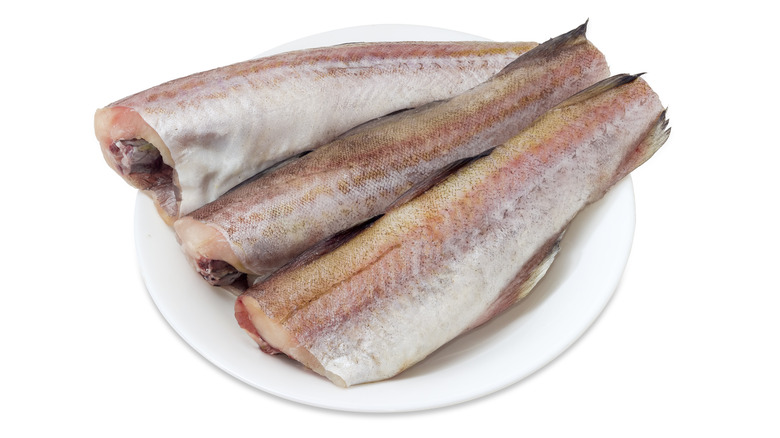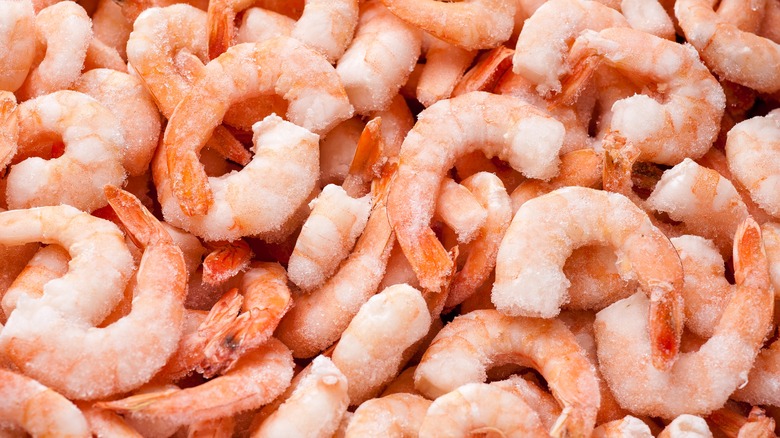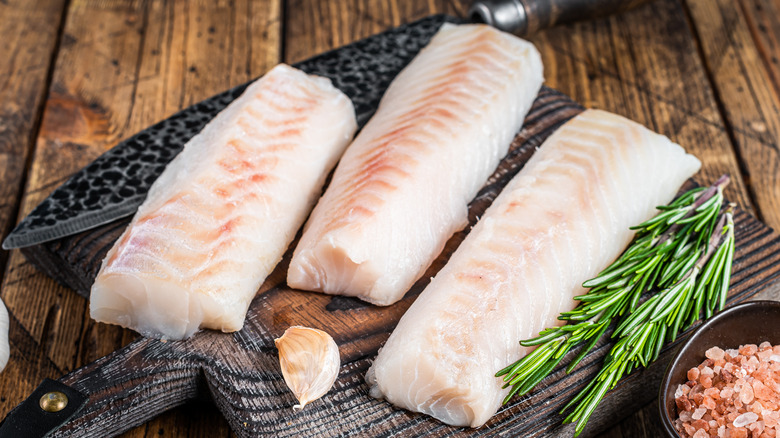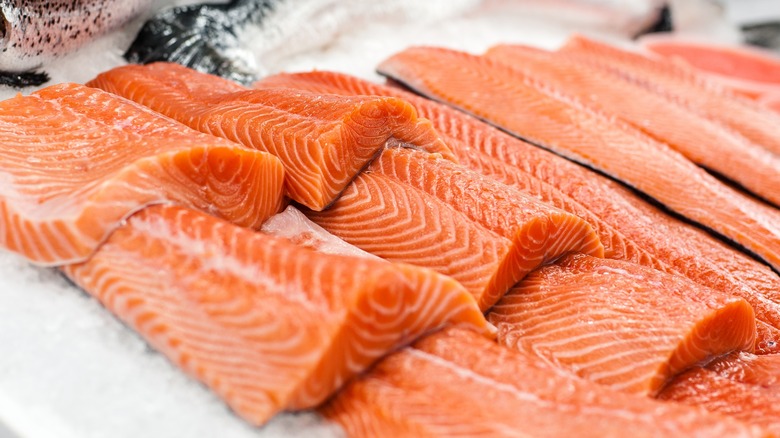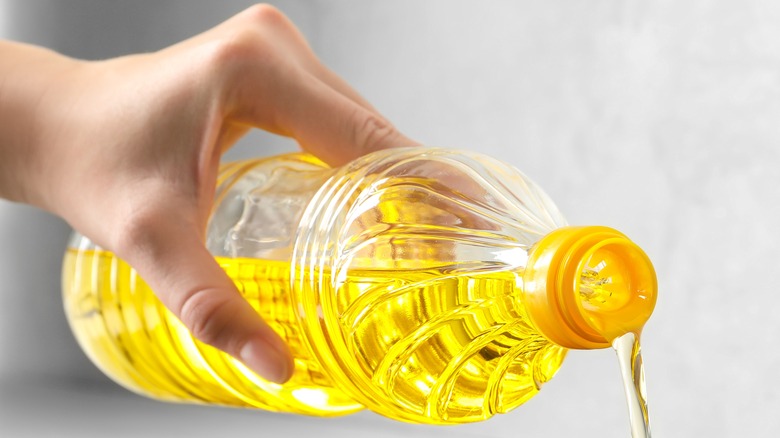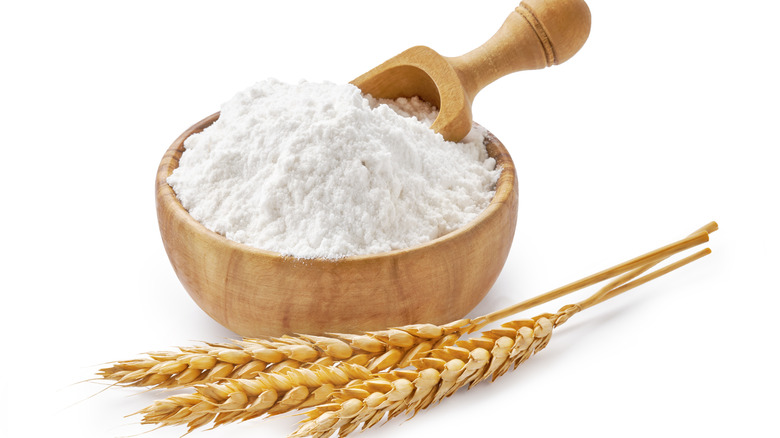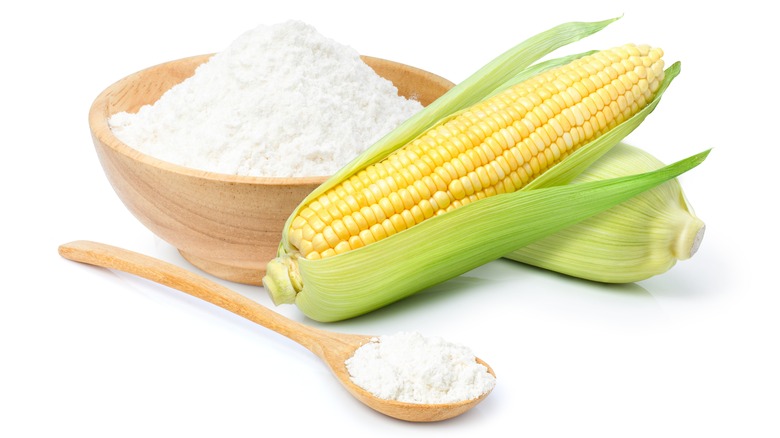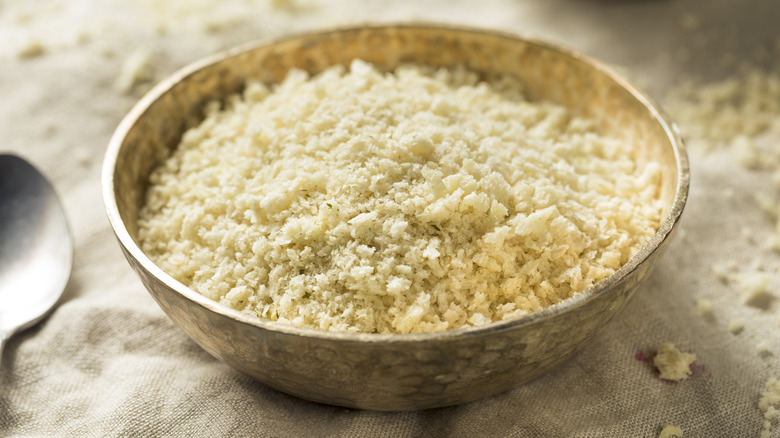What's Really Swimming In Fast Food Fish?
You can't always take an advertisement at face value — particularly with fast food. Quite frankly, no business sector can hold a candle to the quick-service industry, at least when it comes to the tendency to mislead customers through arguably dishonest (if technically legal) marketing. In fact, while fast food chains may say that a seafood-based menu item is made with 100% real fish, savvy shoppers know there's more than just aquatic protein in their meal.
To be clear, that's not necessarily a bad thing. No one expects their Filet-O-Fish to be served sans additional ingredients, after all. Neither does it imply that fast food fish items are completely devoid of fish (there are some lines even big chains won't cross). But simply stating that a place uses seafood in its products leaves much to the imagination and rarely covers the overall composition of a fish sandwich.
Given the bounty of edible fish species that could be utilized by fast food chains, as well as the number of non-seafood ingredients commonly found in fast food fish items, many consumers may be unaware of what's actually in their order. If you're curious, we've got you covered (like we always do!). Without further ado, here are the answers to that eternal question: what's really swimming in fast food fish?
Alaska pollock
Ask consumers to name the first fast food fish item that pops into their head, and we'd bet most would say a fried fish sandwich. Now, battered and deep-fried fish sandwiches aren't the only seafood items on the menu, but fish sandwiches are the clear king of the sea when it comes to fast food. In that sense, just as fish sandwiches appear more prominently than other seafood products, Alaska pollock seems to be the preferred choice for many of those sandwiches served up by fast food restaurants.
Alaska pollock is known for its unintrusive, relatively mild flavor. In other words, this white fish is a near-perfect choice for fast food sandwiches. Additionally, since Alaska pollock is quite amenable to the infusion of external flavors, it allows other ingredients to shine.
From McDonald's enormously popular Filet-O-Fish, to a well-known Long John Silver's menu item, Alaska pollock is widely used in the fast food industry. So if you're ever unsure about what's swimming in fast food fish (you know, fish-wise), don't be surprised if Alaska pollock is the animal du jour.
Shrimp
By and large, fast food fish sandwiches tend to include a white fish species like Alaska pollock as the main ingredient. But just as fried fish sandwiches aren't the only type of fast food seafood available, not all fast food fish menus use a run-of-the-mill, white-fleshed protein. As evidenced by Popeyes and its occasionally-available Shrimp Roll (or its now-discontinued Shrimp Po'boy), you might have shellfish swimming in your order, as well.
Of course, as fans of Popeyes' fried shrimp are aware, the chain's deep-fried popcorn shrimp isn't relegated to the occasional sandwich. Just like the bevy of shrimp-centric meal options offered by Long John Silver's, Popeyes' popcorn shrimp currently appears to be a year-round, full-time menu item.
Seeing how shrimp is almost always found in fast food fish items that promote shellfish as an ingredient, it's a fitting entry for this list. If a menu item in question is shrimp-focused, you can be confident in guessing it does, in fact, have shrimp.
Cod
Every New Englander worth their salt knows the ocean waters around Cape Cod are overflowing with cod ... or, at least, they used to be. Thanks primarily to overfishing, cod has been found less and less often in the southern Massachusetts region and beyond in recent decades. Of course, just because the white-fleshed fish may be increasingly scarce in Cape Cod doesn't mean it's entirely extinct — a fact demonstrated by the fish's sporadic appearance on fast food menus around the U.S.
Like Alaska pollock, cod's mild flavor makes it perfectly suited for fast food fish sandwiches. Actually, its versatility makes cod a good choice when crafting any fish sandwich — be it from a fast food chain like Culver's or one whipped up in a seaside shack in Provincetown.
Even if it's not used quite as often as Alaska pollock in the fast food world, there are still plenty of examples of cod in fast food fish products. Since its not-very-fishy taste makes it one of the better seafood options for people who don't like fish, cod is unlikely to disappear from fast food menus anytime soon (unlike the shores of Cape Cod).
Salmon
To be perfectly honest, some readers may take issue with our decision to feature salmon among the various other ingredients found in fast food fish. By all accounts, it appears that the only fast food chain that offers salmon consistently (or at all, for that matter) is, as of this writing, Long John Silver's. But we're nothing if not thorough here at Mashed, and since Long John Silver's is arguably the quintessential American fast food seafood chain, we think it's fair game to highlight its salmon-based menu items when discussing fast food fish.
If nothing else, the rationale behind salmon's rare usage at fast food chains seems rather apparent. It's not what most folks would consider a cheap or cost-effective fish. While it's immensely unlikely any fast food company would use the exorbitantly-priced king salmon in a menu, it's also easy to imagine that a budget-minded customer would instinctively pass over anything salmon-based.
Since Long John Silver's uses keta salmon (otherwise known as chum salmon) in its grilled salmon meals, it's not nearly as pricey both for the restaurant and the consumer. Perhaps, salmon could still be destined to overtake the fast food fish market some day — but we won't hold our breath underwater while we're waiting.
Flounder
To readers who found themselves immediately repulsed at the idea of devouring Ariel's best pal from "The Little Mermaid," we've got some good news for you. First off, the animated flounder (cleverly named Flounder) wasn't an actual flounder fish. Secondly, well ... he was a cartoon, for goodness' sake. In other words, you don't need to worry about eating Flounder when you order flounder from a fast food restaurant.
Interestingly enough, it currently seems that the only widely available example of this mild-tasting white fish (notice a pattern?) is the limited-time Popeyes Flounder sandwich. Though the sandwich is unavailable as of September 2023, it appears to be offered seasonally by the popular chain. Moreover, this menu item fits the topicality of this article to a T.
Perhaps flounder won't be swimming in your fast food fish order very often. But since it does indeed make the rare appearance on fast food menus, it's worth mentioning (although many migth argue that's never worth looking at a live flounder).
Water
Fish live in the water. Even a toddler who's yet to learn how to form full sentences knows that simple fact. Of course, while fish and water go together like birds and the sky, that doesn't mean you'd necessarily expect the basic liquid component to be found in a cooked seafood dish. But expectations don't always match reality and, thanks to the need to ensure an order retains moisture throughout the cooking process, there's a decent chance your fast food fish didn't simply come from water — it contains water, too.
There's no shortage of fast food fish items currently on the market that list water front and center (or, at least, right after the seafood itself) among the ingredients. Perhaps including this indescribably versatile building block of life in a crispy fish product might seem counterproductive from afar. After all, no one wants to eat a soggy, sloppy piece of fish.
But like so many other food recipes in the world, the addition of water doesn't remotely ruin the final product. After all, if you weren't aware of its usage, would you have ever guessed it was included in your fast food fish in the first place?
Vegetable oil
With the fairly notable exception of Long John Silver's line of grilled salmon menu options, the fast food fish game belongs to the deep-fried arena. In fact, we're willing to predict that the vast majority of fast food customers expect their seafood order from Burger King or Wendy's to star a piece of battered fish — specifically, one that's been cooked in a vat of bubbling oil. Unsurprisingly, then, there's a better-than-average chance that your fast food fish took a swim in vegetable oil on its way to you. That ingredient may even be included inside the item, as well.
Just like any corn dog worth its salt (an ingredient we'll address momentarily) is prepared by being immersed in an oil-filled deep fryer — thus absorbing the oil in the process — many popular fast food fish products are cooked in vegetable oil of some sort. More than that, certain fast food fish items also list vegetable oil as an ingredient used in the preparation process (it's the third-most prominent ingredient in McDonald's Filet-O-Fish, after all).
Whether vegetable oil is contained within a piece of fast food fish itself or simply prepared to order in a boiling hot container of the stuff, you shouldn't be surprised to find the pantry staple in your order of fast food fish.
Wheat flour
Just as many fast food chicken nuggets aren't made from 100% pure poultry, it stands to reason that no fast food fish item's ingredient list starts and ends with seafood. That's not a problem, of course, since there are very few single fast food item anywhere that are made out of just one ingredient with absolutely no additives. Consider how deep-fried fast food fish items don't come straight from the ocean caked in a rich, tasty batter. With that in mind, it's no surprise you're likely to find wheat flour included in your fast food fish.
Of all the commonly used fast food fish ingredients we uncovered during our research, none may have been more expected than wheat flour. Flour is essential to creating a crispy outer coating for any battered and fried food, after all. That holds true whether it's chicken, Twinkies, or fast food fish.
We don't think it's unreasonable to assume that nearly every fried fast food fish item on the market contains wheat flour in some capacity (outside of a gluten-free alternative, of course). So the next time you're wondering how the crunchy exterior of your fast food fish was formed, remember the power of flour.
Modified food starch
Would anyone ever consider categorizing, well, anything related to fast food menus under a minimally processed banner? We doubt it. Maybe some would be tempted to tip their cap to the handful of fast food burger purveyors that offer fresh, never-frozen beef — but we wouldn't often be among that group. With no real debate over whether or not fast food fish is remotely akin to ocean-to-table seafood, it's no mystery to learn that modified food starch (or modified corn starch) is so frequently used in many fast food fish recipes.
Often deployed in the mass production of food items as a thickening agent, it's quite clear why modified food starch is so common in fast food fish. If a customer orders fried fish off the menu at their local fast food spot, they expect the outer layer of that patty or filet to be delightfully crisp and evenly-distributed (not to mention remaining attached to the inner protein while they're eating it). Food starch is key to fulfilling those wants.
Additionally, modified food starch may help retain the overall quality of fast food fish when frozen, as it can reduce the risk of the outer batter layer from breaking down or separating during the freezing process. It's easy to see why this food additive is so prevalent in many mass-produced fast food fish products.
Panko breadcrumbs
We're not entirely sure how panko breadcrumbs became synonymous with fancy pants-style breaded and fried foods. But there's a reason yacht club staff members ask "how pank'd?" whenever members order panko-breaded delicacies (or so we hear). Regardless of the specifics, there's no denying many restaurants (particularly those within the fast food industry) attempt to project an upscale image when it comes to their fish-centric menu by utilizing panko breadcrumbs. However, words can be tricky, and the precise phrasing in certain instances makes it unclear how authentic some item's panko credentials truly are.
Take, for instance, both Burger King's Big Fish sandwich and Wendy's limited-time Crispy Panko Fish Sandwich. Now, we're not prone to calling any business or person a liar without solid proof to back our claim ... and we're certainly not doing that here. But we can't help but find something untoward when we see that both fast food companies describe their products as using panko breading instead of fresh and properly crispy panko breadcrumbs.
Are we being unnecessarily nitpicky regarding semantics? Most certainly. It's highly unlikely a fast food chain would risk its reputation by brazenly lying about using panko breadcrumbs for its fish. It's all but certain the Japanese-invented product will indeed be found in those fast food items, but we'll leave it up to you to decide if it's been used well.
Salt
It's tough to top the importance of salt when it comes to concocting a delectable dish. Fast food fish items are no exception to this rule. When you consider the generally absurd amount of sodium that can be found in many fast food products, why anyone would be shocked to discover salt is inside their fast food fish order is beyond us.
We're not saying that your quarter-pound order of popcorn shrimp from Popeyes is as heavily salted as a piece of cod that's being prepared for months-long preservation. But there's simply no way around the fact that any fast food fish item will have some level of sodium chloride included in the mix — and maybe more than you should have on a regular basis.
If you're concerned about the amount of salt that's swimming around inside your fast food fish, perhaps you should consider doing some swimming yourself (or any exercise, really). After all, one of the best ways to overcome high sodium intake is through physical activity, which may even bolster your blood pressure against excessive salt intake, as per the American Journal of Epidemiology. And if you're consuming fast food on the regular, developing a good aerobic routine is very definitely a smart move.
Sugar
Despite widespread misconceptions, not every processed food item in the 21st century contains added sugar. Still, we were sort of surprised to discover that many fast food fish products don't mention sugar among their ingredients (or in the corresponding nutritional facts). But that doesn't mean there's no sugar to be found in any fast food fish item — just ask the Filet-O-Fish.
To be fair, the Filet-O-Fish isn't the only fast food fish item on the market that lists sugar as an ingredient. But seeing how the international fast food giant mostly seems to offer products that are overloaded with fat, salt, and sugar — in hopes of hitting the brain's reward center after food hits a customer's palate — we can't say we expected anything less from Mickey D's seafood department. Sugar makes a person more apt to crave sugary products in the future, after all, and where else would the restaurant want those Filet-O-Fish fans to head when a craving strikes?
Of course, considering the way that sugar enhances the taste of many foods, no one can really blame those fast food restaurants that choose to add a spoonful of sugar to help the fish order go down.
